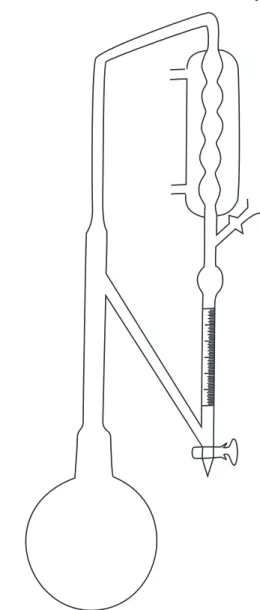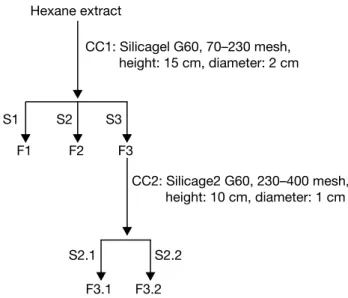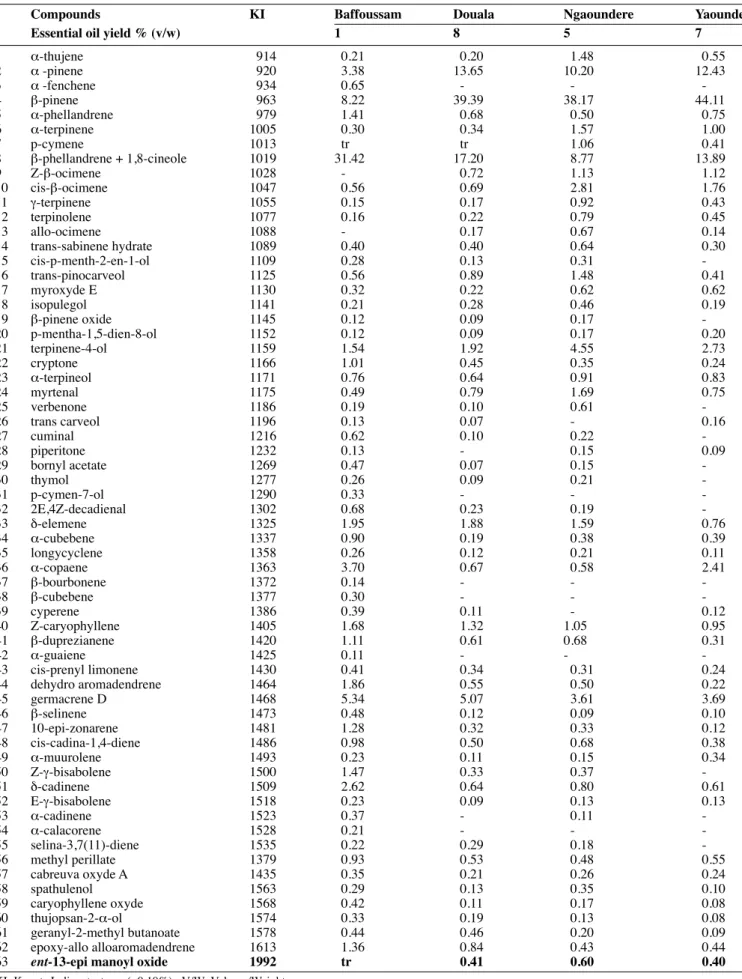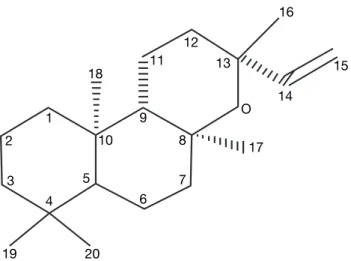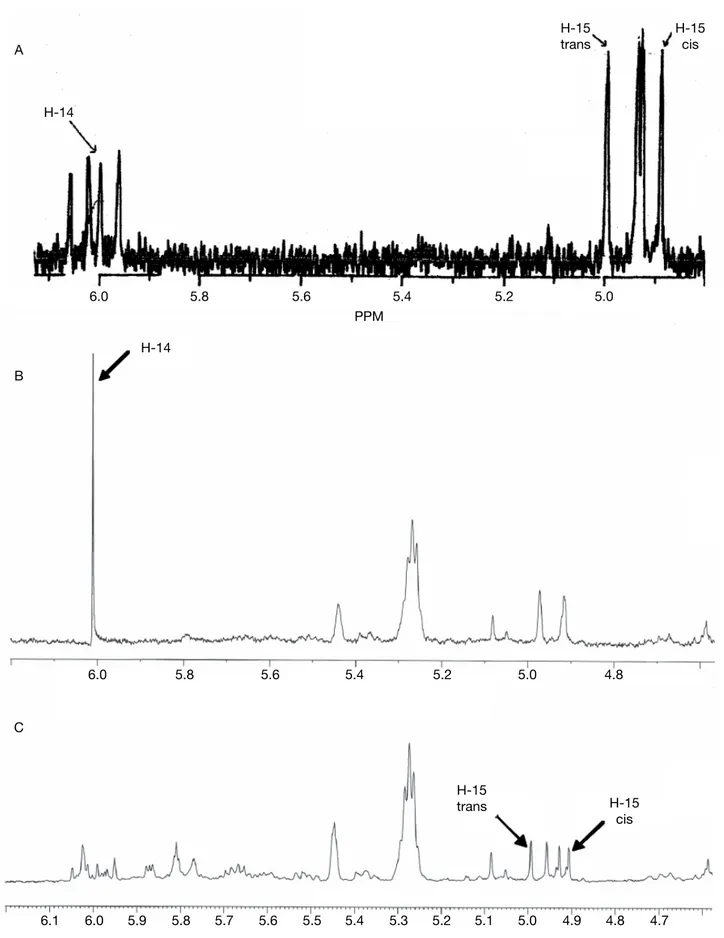S E Biotechnol. Agron. Soc. Environ. 2007 11 (3), 193–199
1. INTRODUCTION
Xylopia aethiopica is a tree of more than 20 m of
height and 60–75 cm of diameter which grows in the forest zone and especially along the rivers in arid areas. The fruit is a slightly hooked cylindrical pod reaching 2–3 mm in width. The mature fruits of green colour take a brown-black coloration after drying and are used as spices (often instead of pepper), in traditional medicine (against the fl u, the bronchitis and the dysentery).
Several studies are reported on biological activity of
X. aethiopica. Fruit powder, its essential oil (Okonkwo,
Okoye, 1996; Ngamo et al., 2001; Kouninki et al., 2005) or leave essential oil (Asawalam et al., 2006) can be used
against cowpea bruchid Callosobruchus maculatus (Fab.) (Coleoptera: bruchidae) or maize weevil Sithophylus
zeamais Motsch. (Coleoptera: curculionidae). X. aethiopica is also active against the termites and
other bugs who tackle wood (Ladjide et al., 1995). The microbiological activity of X. aethiopica essential oil against Escherichia coli, Staphylococcus aureus or
Aspergillus fl avus, among other microorganisms, has
been well established (Tatsadjieu et al., 2003; Asekun, Adeniyi 2004; Konnings et al., 2004).
Among the compounds that confer to X. aethiopica its biologic properties one can mention, the diterpenes belonging to the kauranes, the trachylobanes and the kolovanes families (Hasan et al., 1982; Harrigan et al.,
Composition of Xylopia aethiopica (Dunal) A. Rich
essential oils from Cameroon and identifi cation of a minor
diterpene: ent-13-epi manoyl oxide
Félicité Noudjou
(1,3), Habiba Kouninki
(2,3), Thierry Hance
(2), Eric Haubruge
(1), Léonard
ST. Ngamo
(3), Pierre M. Maponmestsem
(3), Martin Ngassoum
(3), François Malaisse
(1),
Michel Marlier
(1), Georges Lognay
(1)(1) Faculté universitaire des Sciences agronomiques de Gembloux. Passage des Déportés, 2. B-5030 Gembloux (Belgique). E-mail : noudjou.f@fsagx.ac.be
(2) Unité dʼÉcologie et de Biogéographie. Université Catholique de Louvain. 4-5, place Croix du Sud. B-1348 Louvain-la-Neuve (Belgique).
(3) Université de Ngaoundéré. BP 455, Ngaoundéré (Cameroun). Received on 22 August 2006, accepted on 3 July 2007.
Xylopia aethiopica (Annonaceae) essential oil was extracted from fruits collected in four localities in Cameroon, and analysed by GC/MS and GC/FID. More than sixty compounds were identifi ed with 47.5–84.0% of monoterpenes hydrocarbon, mainly β-pinene and β-phellandrene+1,8-cineole, 6.5–12.9% of oxygenated monoterpenes, 13.8–30.4% of sesquiterpenes, and 0.4–0.6 % of a minor unidentifi ed diterpene. Trials of purifi cation by column chromatography, followed by GC/MS and NMR analysis led to the identifi cation of ent-13-epi manoyl oxide which is reported for the fi rst time as a minor component in X. aethiopica essential oil.
Keywords. Xylopia aethiopica, essential oil, β-pinene, β-phellandrene+1,8-cineole, ent-13-epi manoyl oxide.
Composition des huiles essentielles de Xylopia aethiopica (Dunal) A. Rich du Cameroun et identifi cation dʼun diterpène : ent-13-epi manoyl oxyde. Lʼhuile essentielle des infrutescences de Xylopia aethiopica (Annonacée), de quatre localités du Cameroun, a été analysée par GC/MS et GC/FID. Plus de soixante composés ont été identifi és avec 47,5–84,0 % de monoterpènes hydrocarbonés, principalement le β-pinène et un mélange de β-phellandrène et de 1,8-cinéole, 6,5–12,9 % de monoterpènes oxygénés, 13,8–30,4 % de sesquiterpènes, et 0,4–0,6 % dʼun diterpène non identifi é. Les essais de purifi cation sur colonne chromatographique et des analyses par GC/MS et RMN ont permis dʼidentifi er ce diterpène comme étant le ent-13-epi manoyl oxyde qui est rapporté pour la première fois dans lʼhuile essentielle des fruits de X. aethiopica.
1994). It is also noticed that the features of the ether extract of X. aethiopica are favorable to its incorporation in the resins used for the manufacture of the paintings (Ajiwe et al., 1998).
The composition of fruit essential oil of X. aethiopica given in the literature, shows that it is constituted of monoterpenes hydrocarbon. These compounds are represented mainly by β-pinene 37.0–40.5% (Tomi
et al., 1996), 12.0–42.0% (Ayedoun et al., 1996), 18.3%
(Jirovetz et al., 1997) 9.9–19.1% (Keita et al., 2003) or by sabinene 36.0% according to Poitou et al. (1996). Germacrene D is the most important sesquiterpene and the oxygenated compounds are mainly the 1,8-cineole and the terpinen-4-ol. A survey undertaken on
X. aethiopica essential oil from Egypt showed very
particular composition with more than two third of oxygenated compounds 23.4% of terpinen-4-ol, 16.3% of 1,8-cineole and 11.1% of α-terpineol (Karawya
et al., 1979). A similar composition with oxygenated
monoterpenes (15.1% of 1,8-cineole, 6.6% of terpinen-4-ol) has been reported in essential oil from Nigeria (Asekun, Adeniyi, 2004).
The aim of the present work is to study the composition of X. aethiopica essential oil from four localities in Cameroon, and to emphasize the occurrence of a diterpene never mentioned in X. aethiopica essential oil which appears to be ent-13-epi manoyl oxide.
2. EXPERIMENTAL 2.1. Essential oil extraction
Dried fruits of X. aethiopica were obtained from four localities: Bafoussam, Douala, Ngaoundere and Yaounde.
They were ground and subjected to hydrodistillation during four hours using a Clevenger-type (Figure 1) apparatus. Yellowish essential oils were then obtained.
2.2. Extraction and purifi cation of a natural diterpene
The isolation of enriched fractions containing a natural diterpene were carried out on n-hexane extracts from ground fruits since its content in the essential oil is too low (<1%). Ground fruits (30 g) were mixed with 200 ml of n-hexane and the raw extract (300 mg) was fractionated by successive column chromatography purifi cations with silica gel G60 (5% water content). Several preliminary trials have been undertaken and the optimized protocol is summarized in fi gure 2.
2.3. Gas chromatography and gc-ms analyses
GC analyses were performed on an Agilent 6890 series apparatus fi tted with a split/splitless injector
(splitless mode). The operating conditions were as follows: 30 m*0.25 mm HP 5MS (crosslinked 5% phenyl dimethylsiloxane), fi lm thickness: 0.25 μm, temperature programme: from 40°C–230°C at 5°C/ min with a fi nal hold of 5 min. at 280°C. Helium at 49.9 KPa was used as carrier gas and the FID detector was maintained at 250°C.
The oil constituents were identifi ed on the basis of their retention and fragmentation data by using GC/MS analytical conditions similar to that of GC-FID. The mass spectra were recorded on a Agilent 5973 mass spectrometer coupled to an Agilent gas chromatograph (EI mode 70eV, source temperature 230°C, scanned mass ranged 35 to 350 amu). The characteristic fragmentation patterns have been analysed and compared to those of Wiley 275.L database. The retention data (retention indices) were compared to those of Adams (2001) and Joulain and König (1998).
Figure 1. Clevenger-type apparatus — Appareil de type Clevenger.
2.4. NMR analysis
Fraction F3.2, collected during column chromatography, was analysed by NMR (CDCl3, 500MHz) in the Unit of Structural Chemistry and Reaction Mechanisms (CSTR) of the Catholic University of Louvain-la-Neuve (Belgium).
3. RESULTS AND DISCUSSION
The four analyzed samples contained mainly monoterpenes hydrocarbons (41.76–77.04%), in particular α-pinene (3.38–13.65%), β-pinene (8.22– 44.11%). The β-pinene appears like an important compound in the essential oil of X. aethiopica since it is also the major compound in the oil of Guinea with 37.00 to 40.50% (Tomi et al., 1996), of Mali with 9.90% (Keita et al., 2003) and of Cameroon with 18.30% (Jirovetz et al., 1997). However the sample from Bafoussam is particular with 31.42% of β-phellandrene+1,8-cineole against 8.77 to 17.20% for the other samples. With the forementioned analytical conditions, β-phellandrene and 1,8-cineole coeluted, they were therefore summed in table 1. It is noteworthy
that the essential oil originating from Bafoussam contained 14.56% of unidentifi ed compounds each representing less than 1%. The origin of the fruits could explain the differences observed, but also the treatments that the fruits undergo after the harvest. Indeed, according to Ayedoum et al. (1996), the α-pinene and the sabinene can vary respectively from 4 to 16% and 3 to 35% according to whether the fruits are boiled or smoked before the drying.
One particular compound appeared in small amount (less than 1%) at a retention time of 34.2 min. Its molecular ion suggests a diterpene. The molecule, of moderate volatility, was systematically observed after long distillation times and only Jirovetz et al. (1997) mentioned the occurrence of such a compound in the essential oil of X. aethiopica without having proposed any identifi cation. Successive column chromatography purifi cations (Figure 2) led to the recovery of 58.50 mg of an enriched fraction called F3.2 (Figure 3) which contained exclusively diterpenes, notably a derivative of manoyl oxide type. In agreement with Angelopoulou
et al. (2001), the recorded mass spectra and the m/z
(mass to charge ratio)=275 and 257 intensity ratio (ion m/z=257 higher than ion m/z=275), oriented identifi cation toward the ent-13-epi manoyl oxide (Figure 4) rather than manoyl oxide where the two ions are almost equal. Comparing to the 1H NMR spectrum of pure ent-13-epi manoyl oxide (Demetzos et al., 2002), the recorded 1H NMR spectrum (Figure 5) showed the occurrence of the doublets 15 cis and H-15 trans. A selective irradiation at 6 ppm confi rmed the presence of H-14 since the doublets H-15 were reduced to two singlets by suppression of H-14/H-15 coupling. This confi rmed well that the molecule of interest is the ent-13-epi manoyl oxide. Successive injections of the essential oil and the purifi ed product revealed the same kovats index (KI=1992).
4. CONCLUSION
More than 60 compounds were identifi ed in the four samples of X. aethiopica essential oils which show the complexity of this natural extract with insecticide activity (Ngamo et al., 2001; Kouninki et al., 2005). The main chemical compounds are: pinene, β-phellandrene+1,8-cineole, α-pinene, terpinen-4-ol and germacrene D with different content in each sample. With GC-MS and NMR investigations, it was possible to unambiguously identify the ent-13-epi manoyl oxide, a diterpene which is reported for the fi rst time in
X. aethiopica essential oils. Nevertheless due to its very
low proportion in all analysed hydrodistillates it is not established that this molecule could play a signifi cant role in the essential oil activity.
Hexane extract CC1: Silicagel G60, 70–230 mesh, height: 15 cm, diameter: 2 cm S1 S2 S3 F1 F2 F3 CC2: Silicage2 G60, 230–400 mesh, height: 10 cm, diameter: 1 cm S2.1 S2.2 F3.1 F3.2
Figure 2. Column chromatography of hexane extract of Xylopia aethiopica — Chromatographie sur colonne de lʼextrait à lʼhexane de Xylopia aethiopica.
CC: Column Chromatography — Colonne chromatographique; S1: 20 ml of hexane — 20 ml hexane; S2: 30 ml of hexane/diethyl ether: 6/4 — 30 ml hexane/ether éthylique: 6/4; S3: 20 ml of hexa-ne/diethyl ether: 1/1 — 20 ml hexane/ether éthylique: 1/1; S2.1: 7.5 ml hexane/diethyl ether: 6/4 — 7.5 ml hexane/ether éthylique:
6/4; S2.2: 2.5 ml hexane/diethyl ether: 6/4 — 2.5 ml hexane/ether éthylique: 6/4; F1, F2, F3, F3.1, F3.2: collected fractions — frac-tions collectées.
Tableau 1. Composition (%) de lʼhuile essentielle de Xylopia aethiopica provenant de quatre localités du Cameroun.
Compounds KI Baffoussam Douala Ngaoundere Yaounde
Essential oil yield % (v/w) 1 8 5 7
1 α-thujene 914 0.21 0.20 1.48 0.55 2 α -pinene 920 3.38 13.65 10.20 12.43 3 α -fenchene 934 0.65 - - -4 β-pinene 963 8.22 39.39 38.17 44.11 5 α-phellandrene 979 1.41 0.68 0.50 0.75 6 α-terpinene 1005 0.30 0.34 1.57 1.00 7 p-cymene 1013 tr tr 1.06 0.41 8 β-phellandrene + 1,8-cineole 1019 31.42 17.20 8.77 13.89 9 Z-β-ocimene 1028 - 0.72 1.13 1.12 10 cis-β-ocimene 1047 0.56 0.69 2.81 1.76 11 γ-terpinene 1055 0.15 0.17 0.92 0.43 12 terpinolene 1077 0.16 0.22 0.79 0.45 13 allo-ocimene 1088 - 0.17 0.67 0.14 14 trans-sabinene hydrate 1089 0.40 0.40 0.64 0.30 15 cis-p-menth-2-en-1-ol 1109 0.28 0.13 0.31 -16 trans-pinocarveol 1125 0.56 0.89 1.48 0.41 17 myroxyde E 1130 0.32 0.22 0.62 0.62 18 isopulegol 1141 0.21 0.28 0.46 0.19 19 β-pinene oxide 1145 0.12 0.09 0.17 -20 p-mentha-1,5-dien-8-ol 1152 0.12 0.09 0.17 0.20 21 terpinene-4-ol 1159 1.54 1.92 4.55 2.73 22 cryptone 1166 1.01 0.45 0.35 0.24 23 α-terpineol 1171 0.76 0.64 0.91 0.83 24 myrtenal 1175 0.49 0.79 1.69 0.75 25 verbenone 1186 0.19 0.10 0.61 -26 trans carveol 1196 0.13 0.07 - 0.16 27 cuminal 1216 0.62 0.10 0.22 -28 piperitone 1232 0.13 - 0.15 0.09 29 bornyl acetate 1269 0.47 0.07 0.15 -30 thymol 1277 0.26 0.09 0.21 -31 p-cymen-7-ol 1290 0.33 - - -32 2E,4Z-decadienal 1302 0.68 0.23 0.19 -33 δ-elemene 1325 1.95 1.88 1.59 0.76 34 α-cubebene 1337 0.90 0.19 0.38 0.39 35 longycyclene 1358 0.26 0.12 0.21 0.11 36 α-copaene 1363 3.70 0.67 0.58 2.41 37 β-bourbonene 1372 0.14 - - -38 β-cubebene 1377 0.30 - - -39 cyperene 1386 0.39 0.11 - 0.12 40 Z-caryophyllene 1405 1.68 1.32 1.05 0.95 41 β-duprezianene 1420 1.11 0.61 0.68 0.31 42 α-guaiene 1425 0.11 - - -43 cis-prenyl limonene 1430 0.41 0.34 0.31 0.24 44 dehydro aromadendrene 1464 1.86 0.55 0.50 0.22 45 germacrene D 1468 5.34 5.07 3.61 3.69 46 β-selinene 1473 0.48 0.12 0.09 0.10 47 10-epi-zonarene 1481 1.28 0.32 0.33 0.12 48 cis-cadina-1,4-diene 1486 0.98 0.50 0.68 0.38 49 α-muurolene 1493 0.23 0.11 0.15 0.34 50 Z-γ-bisabolene 1500 1.47 0.33 0.37 -51 δ-cadinene 1509 2.62 0.64 0.80 0.61 52 E-γ-bisabolene 1518 0.23 0.09 0.13 0.13 53 α-cadinene 1523 0.37 - 0.11 -54 α-calacorene 1528 0.21 - - -55 selina-3,7(11)-diene 1535 0.22 0.29 0.18 -56 methyl perillate 1379 0.93 0.53 0.48 0.55 57 cabreuva oxyde A 1435 0.35 0.21 0.26 0.24 58 spathulenol 1563 0.29 0.13 0.35 0.10 59 caryophyllene oxyde 1568 0.42 0.11 0.17 0.08 60 thujopsan-2-α-ol 1574 0.33 0.19 0.13 0.08 61 geranyl-2-methyl butanoate 1578 0.44 0.46 0.20 0.09 62 epoxy-allo alloaromadendrene 1613 1.36 0.84 0.43 0.44
63 ent-13-epi manoyl oxide 1992 tr 0.41 0.60 0.40
Acknowledgments
The authors gratefully acknowledge Prof A. Schanck (Unité de Chimie structurale et des Mécanismes réactionnels) of the Catholic University of Louvain (UCL, Belgium) for NMR analyses; and Belgian University Cooperation to the Development (CUD) for fi nancial support of the project “STOREPROTECT”.
Bibliography
Adams RP. (2001). Identifi cation of essential oil components by gas chromatography/quadrupole mass spectroscopy. Carol Stream, Illinois, USA: Allured Publishing Corporation, 456 p.
Ajiwe EIV., Okeke AC., Ogbuagu OJ., Ojukwu U., Onwukeme IV. (1998). Characterisation and applications
pA min 10 20 30 40 50 0 100 200 300 400 500 34.202 m/z Abundance 0 10000 20000 30000 40000 50000 60000 70000 80000 40 60 80 100 120 140 160 180 200 220 240 260 280 300 31 43 55 81 95 109123137 149 163 192 220 230 245 257 275 290
Figure 3. Chromatograph of fraction F3.2 and mass spectrum of ent-13-epi manoyl oxide — Profi l chromatographique de la fraction F3.2 et spectre de masse du ent-13-epi manoyl oxyde.
19 20 1 2 3 4 5 6 7 8 9 10 18 11 12 13 14 15 16 17 O
Figure 4. Formule of the ent-13-epi manoyl oxide — Formule du ent-13-epi manoyl oxyde.
Figure 5. 1H NMR spectra of pure ent-13-epi manoyl oxide (A) and of fraction F3.2 (B,C) — Spectres RMN du ent-13-epi manoyl oxide et de la fraction F3.2 (Demetzos et al., 2002).
H-14 H-15 trans H-15cis 6.0 5.8 5.6 5.4 5.2 5.0 5.6 PPM A B C 6.0 5.8 5.6 5.4 5.2 5.0 4.8 6.1 6.0 5.9 5.8 5.7 5.6 5.5 5.4 5.3 5.2 5.1 5.0 4.9 4.8 4.7 H-15 trans H-15 cis H-14
of oils extracted from Canerium schweinfurttii, Vitex doniana and Xylopia aethiopica fruits/seeds. Bioresour. Technol. 64, p. 249–252.
Angelopoulou D., Demetzos C., Dimas C., Perdetzoglou D., Loukis A. (2001). Essential oils and hexane extracts from leaves and fruits of cistus monspeliensis. Cytotoxic activity of ent-13-epi-manoyl oxide and its isomers. Planta Med. 67, p. 168–171.
Asawalam EF., Emosairue SO., Hassanali A. (2006). Bioactivity of Xylopia aethiopica (Dunal) A. Rich. essential oil constituents on maize weevil Sitophilus zeamais Motschulsky (Coleoptera: Curculionidae). Electron. J. Environ. Agric. Food Chem. 5 (1), p. 1195– 1204.
Asekun OT., Adeniyi BA. (2004). Antimicrobial and cytotoxic activities of the fruit essential oil of Xylopia aethiopica from Nigeria. Fitoterapia 75 (3-4), p. 368– 370.
Ayedoun AM., Adeoti BS., Sossou PV., Leclerq PA. (1996). Infl uence of fruit conservation methods on the essential oil composition of Xylopia aethiopica (Dunal) A. Richard from Benin. Flavour Fragrance J. 11 (4), p. 245–250. Demetzos C., Kolocouris A., Anastasaki T. (2002). A simple
and rapid method for the differentiation of C-13 manoyl oxide epimers in biologically important samples using GC-MS analysis supported with NMR spectroscopy and computational chemistry results. Bioorg. Med. Chem. Lett. 12, p. 3605–3609.
Harrigan GG., Bolzani V. da S., Gunatilaka LAA., Kingston IGD. (1994). Kaurane and trachylobane diterpenes from Xylopia aethiopica. Phytochemistry 36 (1), p. 109–113.
Hasan MC., Healey MT., Waterman GP. (1982). Kolavane and kaurane diterpenes from the stem bark of Xylopia aethiopica. Phytochemistry 21 (6), p. 1365–1368. Jirovetz L., Buchbauer G., Ngassoum MB. (1997).
Investigation of the essential oils from the dried fruits of Xylopia aethiopica (West African “peppertree”) and Xylopia parvifl ora from Cameroon. Ernahrung 21 (7-8), p. 324–325.
Joulain D., König WA. (1998). The Atlas of Spectral Data of Sesquiterpene Hydrocarbons. Hamburg, Germany: EB-Verlag, 658 p.
Karawya MS., Abdel SM., Hifnawy MS. (1979). Essential oil of Xylopia aethiopica fruit. Planta Med. 37, p. 57– 59.
Keita B., Sidibe L., Figueredo G., Chalchat JC. (2003). Chemical composition of the essential oil of Xylopia aethiopica (Dunal) A. Rich. from Mali. J. Essent. Oil Res. 15 (4), p. 267–269.
Konnings GH., Agyare C., Ennison B. (2004). Antimicrobial activity of some medicinal plants from Ghana. Fitoterapia 75 (1), p. 65–67.
Kouninki H., Haubruge E., Noudjou FE., Lognay G., Malaisse F., Ngassoum MB., Goudoum A., Mapongmetsem PM., Ngamo LS., Hance T. (2005). Potential use of essential oils from Cameroon applied as fumigant or contact insecticides against Sitophilus zeamais Motsch. (Coleoptera: Curculionidae). Commun. Agric. Appl. Biol. Sci. 70 (4), p. 787–792.
Lajide L., Escoubas P., Mitzutani J. (1995). Termite antifeedant activity in Xylopia aethiopica. Phytochemistry 40 (4), p. 1105–1112.
Ngamo LS., Ngassoum MB., Jirovetz L., Ousman., Nukenine EC., Mukala OE. (2001). Protection of stored maize against Sitophilus zeamais (Motsch.) by use of essential oil of spices from Cameroon. Proceedings of the 53rd International Symposium on Crop protection, Gent Belgium, 8 May 2001. Meded. Fac. Landbouwkd. Toegepaste Biol. Wet. 66 (2a), p. 473–478.
Okonkwo EU., Okoye WI. (1996). The effi cacity of four seed powders and the essential oils as protectants of cowpea and maize grains against infestation by Callosobruchus maculatus (Fabricius) (Coleoptera: Bruchidae) and Sitophilus zeamais (Motschulsky) (Coleoptera: Curculionidae) in Nigeria. Int. J. Pest Manage. 42 (3), p. 143–146.
Poitou F., Masotti V., Guigues de Souza S., Viano J., Gaydou M. (1996). Composotion of the essential oil of Xylopia aethiopica dried fruits from Benin. J. Essent. Oil Res. 8 (3), p. 329–330.
Tatsadjieu LN., Ngang JJE., Ngassoum MB., Etoa FX. (2003). Antibacterial and antifungal activity of Xylopia aethiopica, Monodora myristica, Zanthoxylum xanthoxyloides and Zanthoxylum leprieurii from Cameroon. Fitoterapia 74 (5), p. 469–472.
Tomi F., Casanova J., Nianga M. (1996). Identifi cation of the seed oil of Xylopia aethiopica from Guinea using 13C-NMR spectroscopy. J. Essent. Oil Res. 8, p. 429–431.
